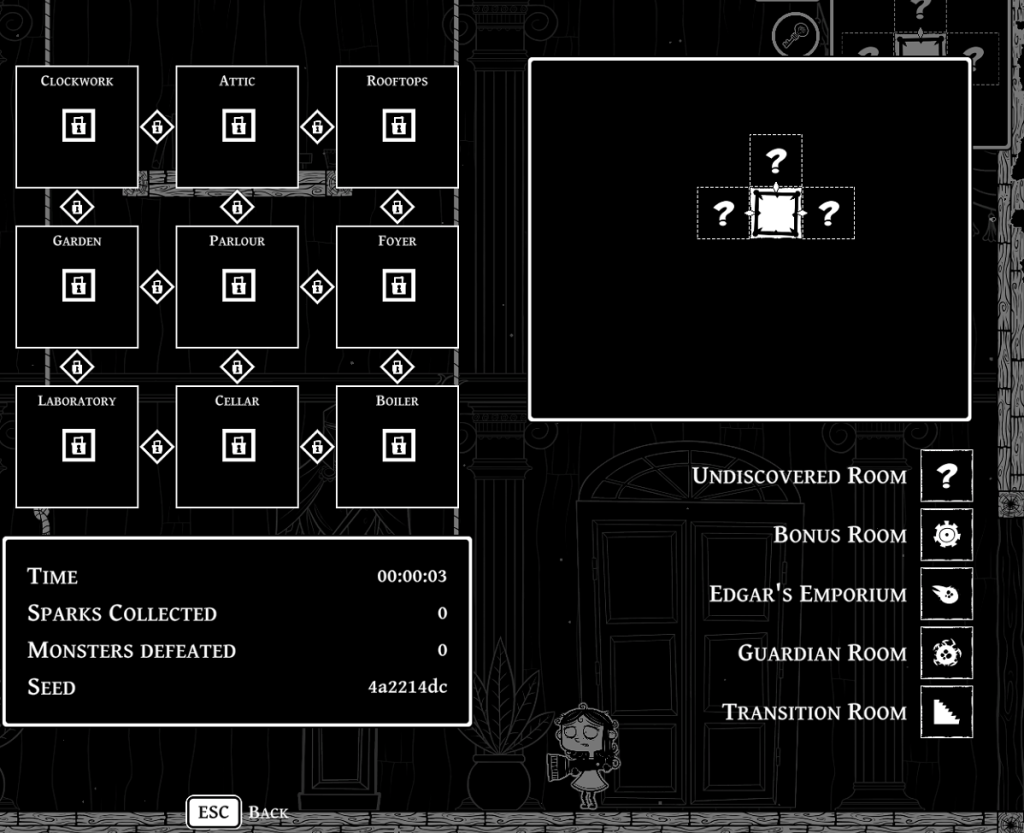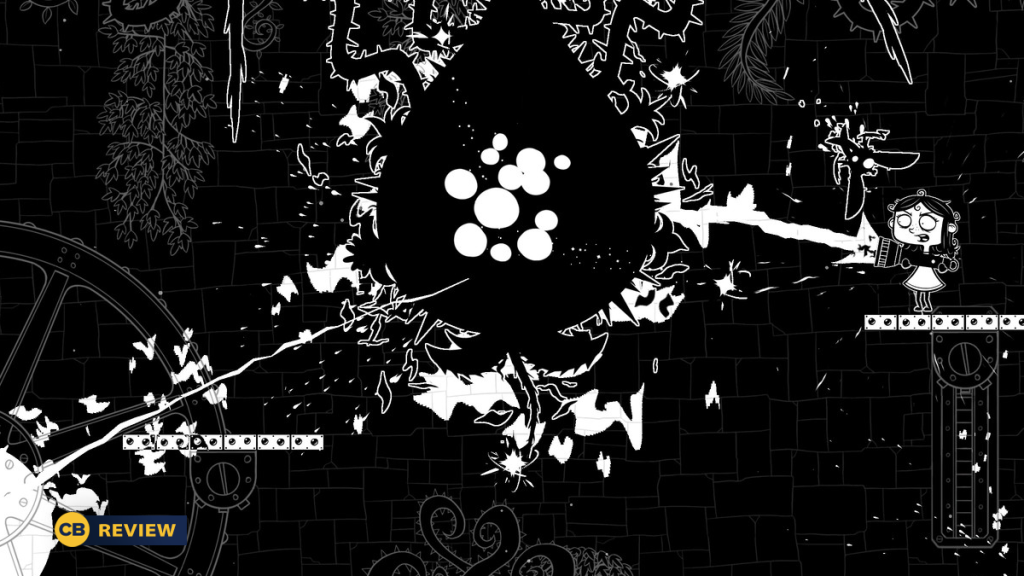Eyes in the Dark: The Curious Case of One Victoria Bloom from developer Under the Stairs puts a unique, shadowy, monochrome twist on the roguelite genre, and it does so with a refreshing amount of creativity and style. Its striking art style meshes surprisingly well with tight controls and gunplay necessary for a game that can be as punishing as this one, and instead of just fueling players’ desire to watch power levels go up and enemies disintegrate, it’s got a compelling story as the backbone, too. Holding it back, however, are some gear options a bit too similar to each other as well as some run-crushing bugs that make it difficult to recommend in its current state.
Videos by ComicBook.com
As the lengthy yet eye-catching title suggests, you play as Victoria Bloom in Eyes in the Dark, the youngest of a lone line of accomplished tinkerers who dabbled in all sorts of other interesting professions. All of that trickles down to the young Victoria who’s got quite the courageous and witty demeanor about her despite facing down a mansion of shadowy creatures with nothing more than a flashlight, a slingshot, and a time-rewinding pocket watch. She must use these items and her own ingenuity to save her grandfather from the Bloom mansion that’s been overtaken by “The Dark,” but that’s really just the surface of the game.
Victoria’s tinkering capabilities manifest themselves through the many upgrades she finds during her loops (or “runs,” for those familiar with the roguelite setup). Though you start out with a basic flashlight and a light-slinging slingshot, you’ll find upgrades along the way whereupon you’re forced to decide what works best for your current build while losing out on the other options. In true roguelite fashion, you lose all of these finds upon starting a new loop but retain at least one currency that fuels your next runs so that at least something is gained even during a loss.
For the most part, these various upgrade paths and complimenting effects will satisfy those constantly looking for “the” build, the one you return to whenever possible where you know you’re in for a good run once everything starts coming together. Eyes in the Dark smartly nudges players towards trying out different combinations, however. For example, a favorite of mine was a flashlight bulb which generates a whip-like beam of light that temporarily extends upon killing a shadowy enemy. It’s superb in most cases, but say you encounter a boss which doesn’t spawn any additional enemies: Not so useful there, is it?
Bulbs, Projectiles for the slingshot, and Gadgets make up the three core types of items and upgrades you’ll find, and while it’s true some favorites will immediately stand out, many of them can be cast aside unless you build is just so in order to make use of them. Some items feel quite similar to another, too. Several Bulbs shoot out bursting bubbles of light, for example, which end up feeling like repeats with negligible differences. The biggest offender is probably Victoria’s shoes which can allow for effects like jetpack propulsion, slow falls, or anti-gravity. If those sound similar, it’s because they are. They all three fulfill the same purpose while cluttering up the item pool. To complicate things, many of the extra items purchased with your retained knowledge currency in order to find them in future runs often feel underwhelming compared to what the game supplies players with to start.
Roguelites and their randomness can sometimes feel oppressive in this way where you feel like you take one wrong turn with an unsuitable build and lose faith in your run, but Eyes in the Dark navigates that by also giving players power over their path through the Bloom mansion. Nine main rooms must be completed to finish a loop, but it’s up to the player how to progress through them. You move from room to room in a 3×3 grid where the top three rooms of the square are always the same three, but they show up in different orders. The same is true for row two and row three, so if you know the boss you hate is in the top row, all you have to do is head that direction ASAP to knock it out as soon as possible before it gets more challenging as the difficulty ramps up with each room.

Planning out a run in terms of your build and the path you take can be a meticulous process, and in this genre, it’s never a welcome feeling to feel like you’re fighting the structure or layout of the game itself in addition to the waves of enemies. That’s thankfully not an issue with Eyes in the Dark since no death ever felt unfair thanks to the clarity offered by the simple black and white style and the tight controls with generous invincibility frames, but one of your greatest threats to a good run is currently a mix of bugs that can bring things to an abrupt halt.
During several runs, I could see the game seemingly coming apart at the seams before the inevitable crash. Doors or projectile indicators would stop working, and areas would start chugging as more projectiles and enemies filled the screen with all that culminating in a crash to the desktop. There’s no way to suspend a run, and the earned currency isn’t retained upon exiting the game that way, so it’s truly a run down the drain if it ends that way. On more than one occasion, bosses (who I’d beaten before and saw how the fight should play out) simply wouldn’t lose health or would disappear from the arena entirely. Again, your only option is to start anew. That happened several times on the final room or two which led to those “walk away” moments where it’s difficult to immediately jump into a fresh run.
The same-y items are a lock it seems, but if the crashes and bugs can be roped in, Eyes in the Dark becomes a tight, stylish roguelite. There’s more to do after the initial run is finished, too – no story spoilers here, but if you enjoy Eyes in the Dark’s premise and time-bending story as well as the rewarding randomness of the genre, you’ll have much more to do after your first run is finished.
Rating: 3.5/5
Eyes in the Dark: The Curious Case of One Victoria Bloom was reviewed on a PC with a review code provided by the publisher
.









